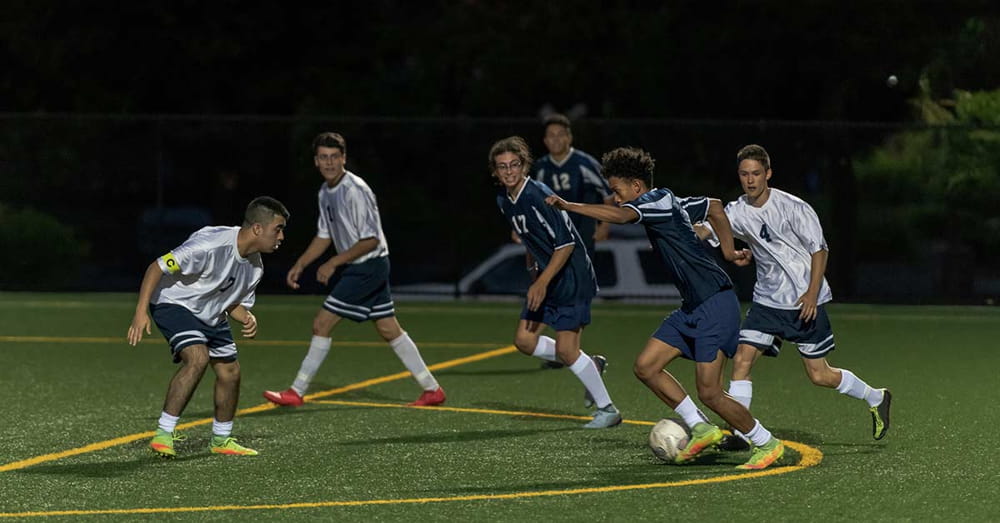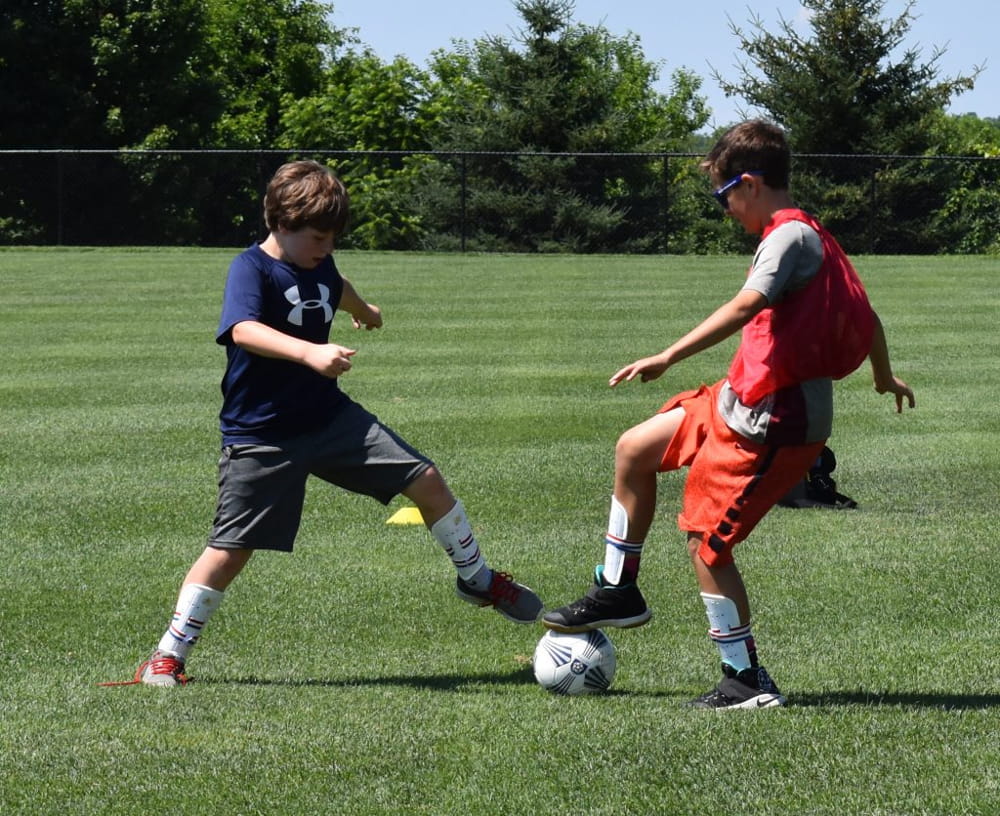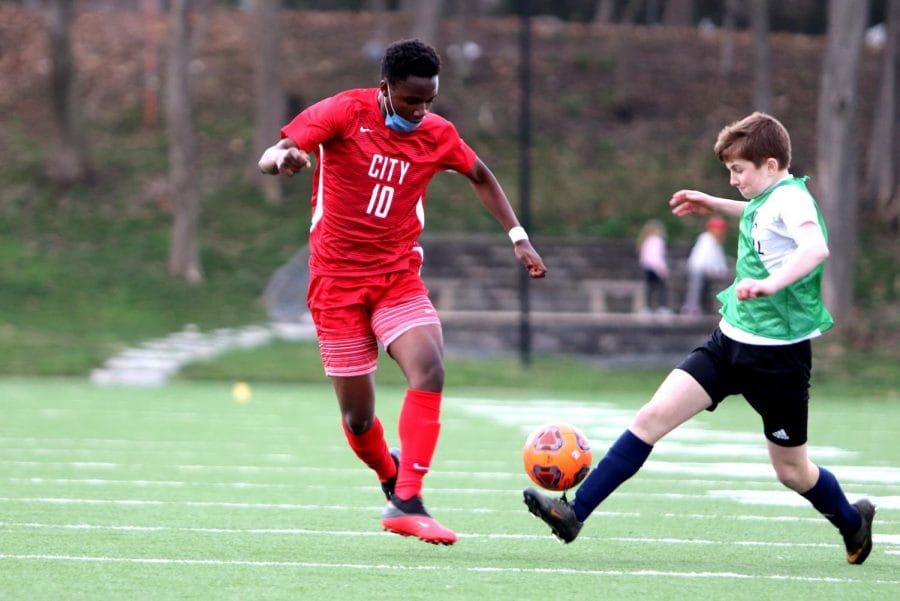How many times you have wanted to be a pro at soccer and wanted to have full grasp on all the terms and concepts that are discussed in soccer?
Well, you are not alone. Many football fans around the world would love to understand the game in more depth and detail than they already do. This article will be your guide to understanding scrimmage in soccer, which is one of the most common terms used when talking about this beautiful sport.
Soccer Scrimmage Definition
A scrimmage in soccer is a practice game played by players of both teams, usually to warm up before the official match that will be held later with the same team but different players. It may also be used as an alternative way to decide who wins if no winner can be decided from playing the full official match. This does not happen in international matches and in large tournaments, but it’s a common practice in many club and school soccer.
Not all matches have scrimmages, so you should not be surprised if your favorite club or national team does not play this kind of match before an official game.
Official Definition And History of Game Scrimmage
You can find the official definition for this term over on the FIFA website. This article will provide you with a quick overview of what is in that page, in case you do not have time to read through it all. The term “Scrimmage” comes from the English Football Association’s interpretation of Law XII dating back to 1863. The goal was to create a simple method for scoring goals when there are an unequal number of players on each team. This concept came about after they realized their current laws might prove ineffective in this situation.
So, how did they solve this problem? They created a rule that allowed both teams to have one player less than their opponent, so they could enter into a scrimmage to decide who should have the right to take penalty kicks.
The original rule has evolved somewhat over the years, but the basic idea always remains the same. The two teams are placed at opposite halves of a field and try to score goals in their opponent’s goal. Both teams must abide by these rules:
They can only use four players per side A goalkeeper must be on each team There is no offside Unlike regular games, players may leave and enter as they please When a player commits a foul, play is restarted with a free kick for the opposing team From this point onwards, players can re-join either team as long as they stay on their own half until that phase of play is over, at which point they return to their own team
When Should You Play Soccer Scrimmages?
The scrimmage start depends on your team and its opponent. Usually, scrimmages are held one day before an official match, but this is not a fixed rule. If you want to be successful at playing soccer or any other sport, then having a plan is essential for success . This includes planning when you would like the scrimmage to take place as well as preparing yourself from another standpoint .
For example, do you have time to practice goal scoring if the goalkeeper of your side leaves after 15 minutes? How will you feel during play if it’s cold outside or there’s bad weather conditions? Do you know how many players of your squad will show up today? All these questions should be asked and answered before deciding when to play any soccer scrimmage.
Who Can Play Soccer Scrimmages?
In theory, both teams can use as many players as they like to play a scrimmage. However, it’s common practice to use only substitute and reserve players for these kinds of games.
Is There Any Scoring in a Scrimmage?
Scoring is optional and up to the referee and coaches on each team (if they decide to implement it). This is why we mentioned that the goal was originally used solely as a way for officials to separate both sides after they had too many players. There are no other official rules regarding scoring in scrimmages.
The teams usually stay on their own side of the field, as it is assumed that they will not use more than four players as stated in Law XII. If a team wants to use more than four players, they can make two scrimmages and play each one with separate sides. This way there’s no confusion about who has too many players and who does not.
How Long is a Typical Soccer Scrimmage?
A scrimmage usually takes the same amount of time as a regular match, with two halves of 45 minutes each. This means any substitutions must be done during a break in play and take no longer than 10 seconds to make.
If a team scores a goal during a scrimmage, this does not stop the clock . It just results in one added minute at the end of each half. If the referee has to use their whistle for an injury , issue cards or if they need to separate both sides due to fighting or other infractions, then this will stop the clock as well.
Types of Soccer Scrimmage Games?
There are several different types of soccer scrimmages, some more popular than others. The most common types of scrimmages in soccer are:
7v7 Soccer Scrimmage
This is the most practical and commonly used form of scrimmages. It’s usually played by reserves or U-18 teams who want to get a feel for the game, but do not yet have enough experience to play an official match with 11 players per side.
8v8 Soccer Scrimmage
This one is quite similar to the former one, except that it uses more players on each team (eight). The extra player on each team is usually a tactic player, someone with an attacking or defensive mindset, depending on what kind of exercises and practices you intend to conduct during this scrimmage.
Tournament Scrimmage / Small-Sided Scrimmage
Small-sided scrimmages are quite popular and common these days, and they usually involve teams of 4v4 or 5v5 playing each other to win a tournament or some kind of cup. This is great for training young players as well as teams that do not have any substitutes at hand.
Full Game Scrimmage / 11v11 Scrimmage
The most common type of scrimmage is by far the normal 11v11 game. This is exactly like an official match except that you make sure to use less experienced players who are not likely to be chosen for the official game, or at least not in starting lineup. This way you can rest your best players and test out different tactics with other players, experimenting without getting a loss on your record.
Top Scrimmage Benefits
Scrimmages are a great way to practice and improve your team’s skills, especially if you’re a coach of younger players who might not have enough experience to play a normal official match. Here are some benefits of using scrimmages:
You can use as many players as you want, so you don’t have to worry about the 11 on 11 rule quite as much You can experiment with new formations and tactics You can rest some of your best players, making them more likely to stay fresh during the official game
As we already mentioned earlier, there is no risk for losing points in case you lose the scrimmage, which makes it ideal for testing strategies and formation that might otherwise hurt your record. Scrimmages also offer an opportunity to try out different types of players without worrying about points.
Top Scrimmage Disadvantages
The biggest disadvantage of scrimmages is that they are unofficial match, which means you cannot earn any money from them, nor will they help your official record. A second issue with scrimmages is that these kinds of games are not allowed during the regular season in most leagues, so you will have to organize them outside of it.
This can be difficult at times if you’re a professional team since your players need their rest during the off-season and some might even go on holidays or travel overseas for business reasons. You also might not have time to properly prepare for it if this is an impromptu decision (for example, because several injured players have just recovered).
Scrimmage Tips And Tricks
There are a few things you need to bear in mind before organizing a scrimmage. First of all, make sure that this is legal. If you want to do it outside the regular season, remember your league rules and find out if they allow these kinds of unofficial games or not. Remember also to choose a suitable location for the scrimmage so that the players will be comfortable enough to give their best during practice. Apart from that, here are some useful tips:
- Do not try too many new tactics
- Don’t let anyone get hurt
- Try to win like its an official match!
- Use less experienced players
How to Include Scrimmages in Training Schedule?
Scrimmages are usually organized outside the regular season, so it can be quite challenging to find a date for these kinds of games unless you have good connections with other coaches. If you cannot manage that, remember that there is no need to organize just one scrimmage during training sessions. You can still use them as part of your training schedule by choosing the time and place where it fits best between your other exercises. If you want to try out different tactics or formations, make sure to choose a suitable environment for this kind of work before organizing the rest of the drills. We recommend using smaller fields with fewer players on each side if you want to experiment with new strategies, but make sure it’s not too complicated because players might get confused more easily if they’re not used to it.
Scrimmage as a Substitute For an Official Game
It is perfectly legal to organize a scrimmage as a substitute for an official match, which means your players will still be able to earn money from this type of game. If you want to try out different formations and tactics in a real-life training environment but the season has already begun, don’t worry. There are no rules against that and you can find people interested in playing such games with relative ease since nothing is at risk by participating (apart from their time).
Scrimmage Home Advantage
If you play the scrimmage on your home field or away from your main location, bear in mind that there might be some fans who come specifically because it’s a match and they want to cheer for their team. This effect is especially common in the case of professional teams because most fans prefer to watch official games rather than scrimmages, so there might be more people present than usual. Don’t let that intimidate you though; place the ball where it’s supposed to go and focus on having fun!
Conclusion
All in all, scrimmages offer great opportunities for both young and professional teams alike. They provide a safe environment for experimenting with tactics and trying out new players. They are also a great way to improve your team’s skills during the off-season, when there are no official matches to play. So choose what kind of scrimmage you want to organize, pick out some suitable locations and get practicing!



